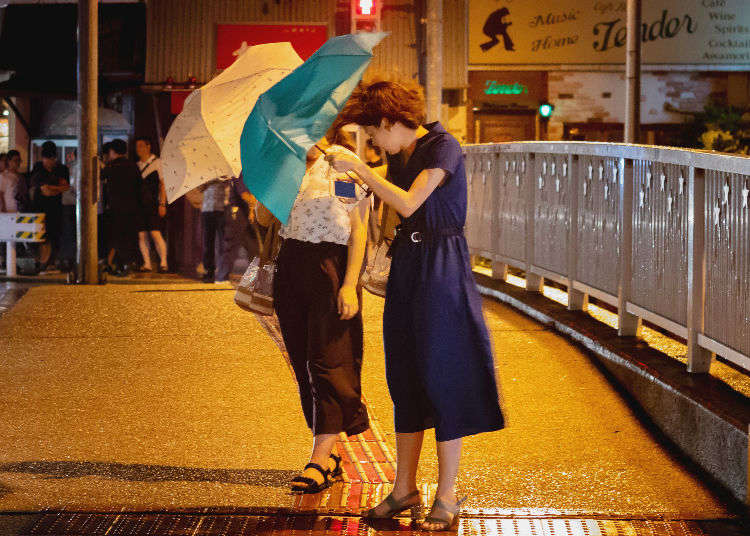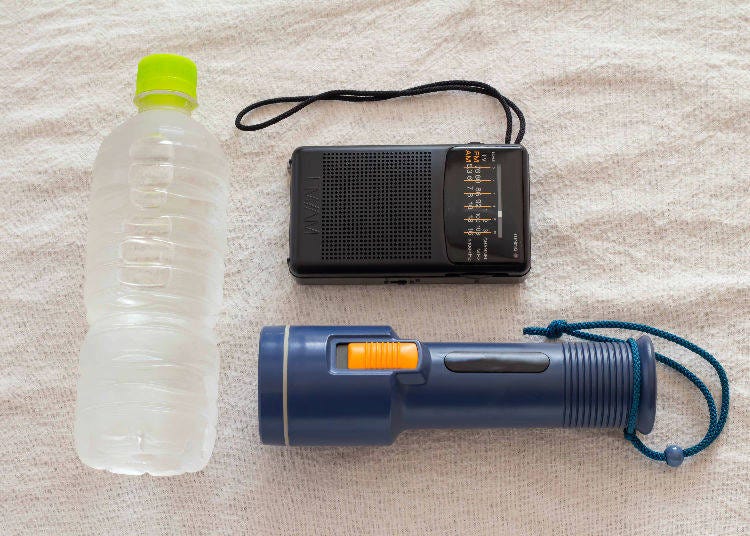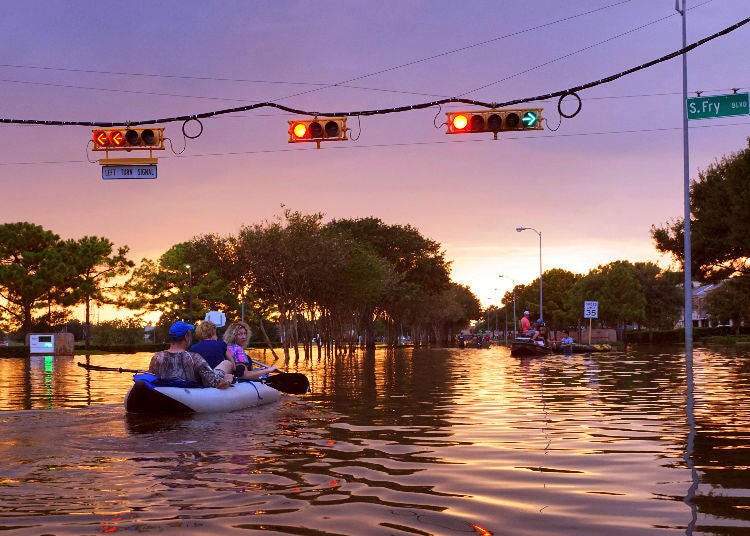
Natural disasters such as earthquakes, typhoons, and tsunamis bring our community infrastructure and economic activities to a standstill while causing enormous damage to the affected areas. Especially typhoons hit Japan several times each year.
Unlike other natural disasters such as earthquakes, it is a natural phenomenon that can be forecasted via weather information. However, typhoons often bring other disasters with them such as floods and landslides. Therefore, typhoons are a phenomenon that requires appropriate measures.
People who have plans to travel to Japan cannot easily judge if they should abandon a trip or what measures to take while you’re here just by looking at the forecast and information alone.
As Japan is hit by multiple typhoons every year, let’s take a look at how to prepare for a typhoon, what to expect, and what to do when the typhoon makes landfall.
Knowing Typhoons in Japan

Japan’s “Typhoon Season”
The timing in which typhoons occur around Japan is an important factor when planning your trip. The Japan Meteorological Agency published data summarizing the average number of typhoons approaching Japan and making landfall between 1981 and 2010.
According to this data, the average number of such typhoons is 14.7 per year. August is at the top with 4.4 annual typhoons while December was the least concern with only 0.1 on average. Furthermore, there is no statistical data for the period between January and March. Typhoons in Japan mostly occur during summer while it can be said that there is little chance during winter.
When do typhoons occur? The signs of a typhoon
The clouds are a reliable sign and useful method to recognize an approaching typhoon. If they are “shaped like cauliflowers,” “mushroom caps,” if they have “a black color,” and so on, these cumulonimbus clouds are a sign that a typhoon is close.
Another indicator is dark clouds covering the sky and heavy rainfall accompanied by strong winds. If you’re visiting Japan during summer, the period in which the country experiences the most typhoons, it is advisable to check the weather forecast and current information frequently.
Apart from typhoons, it is also very difficult to predict other natural disasters such as earthquakes and heavy rainfall. Whenever you are traveling abroad, it is a good idea to periodically check the weather information of the country you are in, not limited to Japan.
Things to Prepare for a Typhoon

When you know that a typhoon is approaching, prepare yourself to prevent any damage as much as possible.
Preparing for heavy rain and strong winds accompanying typhoons
- Typhoons may cause heavy rain and floods, so if you are located on the ground floor, move your belongings as high as possible to prepare for possible flooding. There is also a possibility of electric leaks and shocks, so unplug any home appliances.
- The strong winds of the typhoon may shatter windows, so close the curtains, blinds, and shutters as much as possible.
- Move any outdoor furniture or objects such as veranda chairs or bicycles inside, as they may get blown away or moved around by the strong wind.
Preparing for impacts on water, electricity, and transportation
- Prepare flashlights and candles in case of power outages caused by the typhoon. Keep your mobile phone charged to be able to check the latest information. Keeping your portable charger on hand is also a good idea.
- Prepare drinking water in case of water outages caused by the typhoon.
- Various train lines may stop running as a result of the typhoon or the number of trains may be reduced. A typhoon in the summer of 2018 caused train lines in the Tokyo Metropolitan Area to cease operation after 8:00 p.m. in preparation for a large typhoon. Therefore, keep in mind that the only means of transportation may be taxis or walking. Of course, taxis will be scarce as many people need to get around, so you might have to wait a long time. If you need to get around, consider that you might have to face significant delays.
- While it is best to refrain from going outside as much as possible, keep in mind that even before the typhoon, a lot of commercial facilities might temporarily close or have different opening hours. If you want to make plans before a typhoon, it is best to check in advance.
Acting in anticipation of possible damage
- Typhoons are accompanied by heavy rain that pours down in a short period of time, potentially causing floods and landslides due to raised water levels in rivers. Check the location of rivers and steep slopes in the surrounding area and move away from them either to elevated spots or as far as possible.
- Check the latest information to be aware of the scale of the typhoon before it makes landfall. Take appropriate measures regarding the expected damage from rain and wind.
Understanding information on “rainfall”
- In the case of 80mm of rainfall per hour
Term: 猛烈な雨 mōretsu na ame (torrential rain)
Perceived effect: stifling, a sense of pressure like a difficulty to breathe
Effect on people: umbrellas are entirely useless
Effect on the outside: splashing causes one side to turn whitish, the visibility gets worse, there is a danger of road flooding, floods, and rising water levels.
Traveling by car: dangerous
- In the case of 50-80mm of rainfall per hour
Term: 非常に激しい雨 hijō ni hageshii ame (very heavy rainfall)
Perceived effect: pouring like a waterfall
Effect on people: umbrellas are entirely useless
Effect on the outside: splashing causes one side to turn whitish, the visibility gets worse, there is a danger of road flooding in a wide area
Traveling by car: dangerous
- In the case of 30-50mm of rainfall per hour
Term: 激しい雨 hageshii ame (heavy rainfall)
Perceived effect: pouring like a bucket turned over
Effect on people: wet even with an umbrella
Effect on the outside: the roads become like rivers, water channels and the low parts of roads may flood
Traveling by car: there is a danger of aquaplaning (when a layer of water builds up between the tires and the road)
- In the case of 20-30mm of rainfall per hour
Term: 強い雨 tsuyoi ame (strong rainfall)
Perceived effect: slashing rain
Effect on people: wet even with an umbrella
Effect on the outside: the ground is covered in puddles, gutters may overflow
Traveling by car: the vision is bad even with the highest wiper speed
- In the case of 10-20mm of rainfall per hour
Term: やや強い雨 yaya tsuyoi ame (relatively strong rainfall)
Perceived effect: heavy but normal downpour
Effect on people: feet get wet by the splashing
Effect on the outside: the ground is covered in puddles
Understanding information on “wind speed”
- An average wind speed (m/s) of less than 10-15
Term: やや強い風 yaya tsuyoi kaze (relatively strong wind)
Approximate speed per hour: ~50km
Effect on people: hard to walk against the wind, do not let go of your umbrella
Effect on the outside: whole trees and electric wires sway
Traveling by car: windsocks turn horizontal, driving at high speed feels like getting caught in the cross-wind
Effect on buildings: the rainwater pipes may start to rattle
- An average wind speed (m/s) of less than 15-20
Term: 強い風 tsuyoi kaze (strong wind)
Approximate speed per hour: ~70km
Effect on people: some people may not be able to walk against the wind at all and fall, working at high altitudes is extremely dangerous
Effect on the outside: electric wires start to rattle, signs and metal sheets may be blown off
Traveling by car: strong cross-winds when driving at high speed
Effect on buildings: roof tiles and other roof material may be blown off, shutters are rattling
- An average wind speed (m/s) of less than 20-30
Term: 非常に強い風 hijō ni tsuyoi kaze (strong wind)
Approximate speed per hour: ~110km
Effect on people: impossible to stand unless you hold onto something; flying objects may cause injuries
Effect on the outside: thin trees break and trees with no roots fall, signs fall and get blown around, road signs told
Traveling by car: driving at regular speed becomes difficult
Effect on buildings: roof tiles and other roof material is blown off, prefabricated huts and cabins that are not secured are moved and toppled over, extensive damage to vinyl house siding
- An average wind speed (m/s) of 30 or more
Term: 猛烈な風 mōretsu na kaze (fierce wind)
Approximate speed per hour: ~140km
Effect on people: being outdoors is extremely dangerous
Effect on the outside: many trees fall, utility poles and street lamps fall and bring down other things, block walls collapse
Traveling by car: trucks are toppled over while driving
Effect on buildings: metal roof material with insufficient fixation are blown off, temporary scaffolding that hasn’t been secured enough collapses, steel frame structures may be deformed or collapse in the worse case
- What is the “strong wind area” and the “storm area” named in the context of typhoon information?
- Strong wind area (強風域 kyōfūiki): the area where the average wind speed is over 15 meters per second
- Storm area (暴風域 bōfūiki): the area where the average wind speed is over 25 meters per second

As the typhoon makes landfall, what to do depends on the situation:
While inside a building
- Refrain from going outside.
- If you are underground, evacuation in case of flooding may be difficult, so try to move to the second floor of the building or higher as early as possible.
- Power lines may be damaged by the storm and outages can occur, so avoid using elevators to your best ability.
While outside
- Do not approach a building if there is a possibility that it might collapse.
- The water level of rivers may rise, so stay clear of bodies of water.
- Landslides may occur, so keep away from steep slopes such as mountains.
- Even wires hanging down can cause electric shocks, so do not approach them.
- Evacuate an area for which a landslide warning has been issued. If you see signs for an impending landslide, such as falling pebbles, tell the authorities of that area, such as the municipality, police, firefighters, and so on.
While traveling by car
- A typhoon’s strong winds may topple over the car, so avoid traveling by car to the best of your ability.
- If you are inside a car, go at a slow speed and leave more distance than usual to the car in front of you. Keep in mind that entrances of tunnels, bridges, and roads along the coast may have extremely strong cross-winds.
- Avoid areas that may be flooded.
- If your car gets flooded while you’re inside it, contact road rescue services such as the JAF (Japan Automobile Federation) and ask for assistance.
What to Do When Evacuating from a Typhoon

Where to find evacuation information
In Japan, information regarding evacuation in case of a natural disaster is broadcast on TV and posted on the official websites of municipalities, on social media, and so on. Diligently keeping up with the latest information about the weather and possible evacuation will immensely help to navigate the situation and to prevent possible damage.
Multilingual information can be found on various Japanese websites, such as the Japan Meteorological Agency (https://www.jma.go.jp/en/warn/), NHK (Japan’s national public broadcasting organization, https://www3.nhk.or.jp/nhkworld/), and JNTO (Japan National Tourist Organization, https://www.japan.travel/en/).
There also is an app called “Safety Tips” that is dedicated to providing information related to natural disasters, provided by the Japan Tourism Agency. It is available in five languages (English, Chinese (simplified and traditional), Korean, and Japanese) and does not only deliver early earthquake, tsunami, and weather warnings but offers a wide range of information around the topic of natural disasters. It’s useful to download the app before your trip to receive push notifications in case of disasters and emergencies.
How to download “Safety Tips”
- Android:
https://play.google.com/store/apps/details?id=jp.co.rcsc.safetyTips.android
- iPhone:
https://itunes.apple.com/jp/app/safety-tips/id858357174?mt=8
This sort of weather information also includes the different stages of evacuation that will be sent out in accordance with the situation: preparing for evacuation and evacuation of seniors, recommended evacuation, and an evacuation order (urgent). Let’s take a closer look at each of them.
Preparing for an evacuation, evacuation of seniors
There will be announcements when an evacuation is to be expected, asking people to prepare. That includes specific instructions for people who take longer to evacuate (seniors, infants, people with a disability, and so on) and when the general public should prepare to evacuate.
Recommended evacuation
This information is sent out when the situation surrounding a disaster gets more serious and the possibility for injury rises. In the case of an evacuation order, you need to proceed to the evacuation spot promptly. If it is dangerous and life-threatening to go outside, find shelter according to the situation at a nearby safe place or within your accommodation.
Evacuation order (urgent)
An evacuation order can occur in the wake of especially dangerous disasters when there is a high danger of injury and life. People who have not yet evacuated absolutely need to head to the designated area immediately. If it is dangerous and life-threatening to go outside, find shelter according to the situation at a nearby safe place or within your accommodation.
Confirming dangerous areas, designated evacuation areas, and evacuation routes
- Depending on the local government, an English hazard map is available that details hazardous areas where floods and landslides are to be expected due to typhoons. If you are in Shibuya, for example, refer to the official website of the Shibuya Ward, look up the official information published by the local government of your place of residence or accommodation. Confirm where hazardous areas are, where designated evacuation areas are, and how to get to those evacuation areas with the help of hazard maps.
Clothes for evacuation
- Wear as much rain gear as possible instead of using an umbrella to keep both hands free.
- Wear a helmet or similar head protection against falling objects.
- Wear long sleeves and long pants that are easy to move in.
- Heavy boots get even heavier when wet, so opt for shoes that you would regularly wear and are comfortable to walk in.
- To keep both hands free, use a backpack or similar bag to carry your belongings in.
Points to note when evacuating
- Being by yourself is dangerous, so try to evacuate in a group of as many people as possible.
- If the roads and so on are flooded, test the ground with a stick, umbrella, or similar object. Manholes and drains are dangerous in these situations, so stay clear of them.
- Evacuating in the dark is dangerous, so try to move during the day if possible.
- Choose high, reinforced concrete buildings as shelter.
- If the water reaches up to your waist on roads or other routes, do not try to make your way through but instead seek high ground and wait for rescue.
- If you cannot make it to a shelter or evacuation area designated by the local government due to floods, stay put and request help from the fire department, police, municipality, and so on.
Final Thoughts
Typhoons ruin your trip by canceling a reservation you had or blocking you from visiting that one spot you planned to see. However, ignoring a typhoon making landfall and heading out anyways might get you caught up in floods or landslides.
Confirm the situation via television or online to get accurate information on a typhoon’s severity, its timing, and how to prepare for it in advance. As opposed to spontaneously occurring earthquakes, typhoons can be confidently navigated with plenty of information and preparation!
*Prices and options mentioned are subject to change.
*Unless stated otherwise, all prices include tax.
Popular Tours & Activitiess
Recommended places for you
-

Kanzenkoshitsuyakinikutabehodai Gyugyu Paradise Sannomiya
Yakiniku
Kobe, Sannomiya, Kitano
-

Kambei Sannomiyahonten
Yakiniku
Kobe, Sannomiya, Kitano
-

Jukuseiniku-to Namamottsuarera Nikubaru Italian Nikutaria Sannomiya
Izakaya
Kobe, Sannomiya, Kitano
-

ISHIDAYA Hanare
Yakiniku
Kobe, Sannomiya, Kitano
-
Goods

Yoshida Gennojo-Roho Kyoto Buddhist Altars
Gift Shops
Nijo Castle, Kyoto Imperial Palace
-
Appealing

Rukku and Uohei
Izakaya
Sapporo / Chitose
-

See Asakusa and Tokyo Skytree® in a New Light at the "Také Akari" Festival (Winter 2025-2026)
by: Guest Contributor
-

Enjoy Japan's Gorgeous Winter Lights! Ride the Romancecar to Shonan no Hoseki Illumination
by: Guest Contributor
-
Ad

Walk in the Footsteps of Believers: A 4-Day Pilgrimage Across Goto Islands, Nagasaki Prefecture
by: Yohei Kato
-

LaLaport TOKYO-BAY North Building Now Open: Shop, Dine & Enjoy Events at LaLa arena, Just 2 Stops from Disney
by: Wemmy Chau
-

A Travel Game Changer! Go Hands-Free Between Tokyo and Kyoto with LUGGAGE EXPRESS by JTB and JR Tokai
by: Guest Contributor
-

2025 Japan Autumn Color Report: Tokyo's Ginkgo Trees Starting to Glow
by: Timothy Sullivan
-

20 Best Things to Do in Fukushima Prefecture (Sightseeing Attractions, Local Foods & Activities)
-

Convenience Store Must-Buys! Lawson's Top 5 Popular Sweets
-

3 Best Izakaya In Osaka Where You Can Enjoy Drinks and Local Dishes, Recommended by Locals
-

Top 10 Best Places You Can Visit for Free in Kyoto
-

We have gathered some fashion items from Japan in Marunouchi!
-

Visiting the Sacred Japanese Gardens at Entsuin Temple in Matsushima
- #best sushi japan
- #what to do in odaiba
- #what to bring to japan
- #new years in tokyo
- #best ramen japan
- #what to buy in ameyoko
- #japanese nail trends
- #things to do japan
- #onsen tattoo friendly tokyo
- #daiso
- #best coffee japan
- #best japanese soft drinks
- #best yakiniku japan
- #japanese fashion culture
- #japanese convenience store snacks












